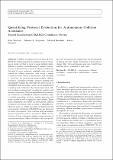Quantifying protocol evaluation for autonomous collision avoidance
Author(s)
Woerner, Kyle; Benjamin, Michael; Novitzky, Michael; Leonard, John J
DownloadFinal Manuscript (2.532Mb)
OPEN_ACCESS_POLICY
Open Access Policy
Creative Commons Attribution-Noncommercial-Share Alike
Terms of use
Metadata
Show full item recordAbstract
Collision avoidance protocols such as COLREGS are written primarily for human operators resulting in a rule set that is open to some interpretation, difficult to quantify, and challenging to evaluate. Increasing use of autonomous control of vehicles emphasizes the need to more uniformly establish entry and exit criteria for collision avoidance rules, adopt a means to quantitatively evaluate performance, and establish a “road test” for autonomous marine vehicle collision avoidance. This paper presents a means to quantify and subsequently evaluate the otherwise subjective nature of COLREGS thus providing a path toward standardized evaluation and certification of protocol-constrained collision avoidance systems based on admiralty case law and on-water experience. Notional algorithms are presented for evaluation of COLREGS collision avoidance rules to include overtaking, head-on, crossing, give-way, and stand-on rules as well as applicable entry criteria. These rules complement and enable an autonomous collision avoidance road test as a first iteration of algorithm certification prior to vessels operating in human-present environments. Additional COLREGS rules are discussed for future development. Both real-time and post-mission protocol evaluation tools are introduced. While the motivation of these techniques applies to improvement of autonomous marine collision avoidance, the concepts for protocol evaluation and certification extend naturally to human-operated vessels. Evaluation of protocols governing other physical domains may also benefit from adapting these techniques to their cases.
Keywords: COLREGS; Autonomous collision avoidance; Human–robot collaboration; Marine navigation
Date issued
2018-05Department
Massachusetts Institute of Technology. Computer Science and Artificial Intelligence Laboratory; Massachusetts Institute of Technology. Department of Mechanical EngineeringJournal
Autonomous Robots
Publisher
Springer-Verlag
Citation
Woerner, Kyle et al. “Quantifying Protocol Evaluation for Autonomous Collision Avoidance.” Autonomous Robots (May 2018): 1-25 © 2018 Springer Science+Business Media, LLC, part of Springer Nature
Version: Author's final manuscript
ISSN
0929-5593
1573-7527